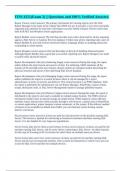Exam (elaborations)
ITSS 4351(Exam 2) || Questions and 100% Verified Answers.
- Course
- Institution
Report Viewer correct answers The primary mechanism for viewing reports over the Web. Report Manager is the name of the website that SSRS sets up. It provides a very clean and neatly organized user interface for end users. Developers can also embed a Report Viewer control into both ASP.NET and Wind...
[Show more]



